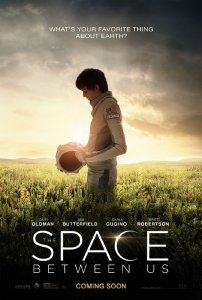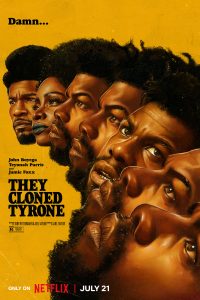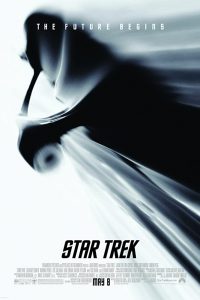The Boy Who Fell to Earth: A Review of The Space Between Us
 by Gary Westfahl
by Gary Westfahl
Like a NASA rocket slowly rising from the surface, The Space Between Us takes a long time to achieve escape velocity and soar through space; however, if you can endure one of the most boring opening sequences in any film I can recall, and about an hour of trite melodramatic sequences interspersed with inauthentic personal drama, its last thirty minutes are actually quite enjoyable, even moving. Whether it is a film worth seeing, then, hinges upon whether you most value the journey, or the destination.
In some respects, the film resembles what might have happened if someone had resolved to finally get a film version of Robert A. Heinlein’s Stranger in a Strange Land (1961) green-lighted by excising all of its controversial elements – the sex, the politics, the religion, the social satire. One would be left with the story of a pioneering female astronaut, Sarah Elliot (Janet Montgomery), who gives birth to a son on Mars and immediately dies, leaving her son to be raised by others (here, human astronauts, not intelligent Martians). As a young adult, Gardner Elliot (Asa Butterfield) is finally able to come to Earth and soon achieves a satisfying romantic relationship with a teenager named Tulsa (Britt Robertson). So described, one imagines the resulting film would become a sensitive, coming-of-age drama involving a troubled youth confronting a challenging adult world, the sort of production that regularly wows audiences at the Sundance Festival and garners Oscar nominations (such as, for example, Moonlight [2016]); and at times, it is evident that director Peter Chelsom and writers Allan Loeb, Richard Barton Lewis, and Stewart Schill were striving to create a film of precisely that nature.
Unfortunately, The Space Between Us was also going to be a science fiction film, and everyone in Hollywood knows that science fiction films have to be filled with action; so, making the same mistake that doomed Tomorrowland (2015 – review here), Chelsom and company dutifully inserted car crashes, an explosion, and several absurd chase scenes – the most risible one involving a car and a vintage biplane. Thankfully, though, Gardner and Tulsa are never called upon to punch out any of their opponents, since their chief pursuers – former project director Nathaniel Shepherd (Gary Oldman) and mothering astronaut Kendra Wyndham (Carla Cugino) – only have Gardner’s best interests at heart, seeking to capture him solely to protect him from the potentially fatal effects of living in Earth’s oppressive gravity. Further, in order to make all of Gardner and Tulsa’s daring escapes even barely plausible, the film necessarily posits that NASA has been keeping Gardner’s existence a secret for sixteen years, hindering their efforts to locate and seize him. Yet despite some sporadic, halfhearted explanations, the film never manages to articulate a truly convincing reason for all this secrecy, which is being maintained solely to keep the plot in motion. In addition, it is a Hollywood truism that the course of true love never runs smooth, so despite their long-time online friendship, Gardner and Tulsa must constantly bicker, for one idiotic reason after another, generating additional “conflict” in the interludes between their exciting escapades.
Instead of providing viewers with frenetic chases and contrived arguments, which they have all seen many times before, The Space Between Us would have been better advised to focus on more original material – namely, how Earth would be perceived by a visitor from an alien planet. There are only scattered scenes of this nature: while Tulsa is admiring a vast canyon, Gardner is fascinated by a caterpillar – for he has seen many barren landscapes before, but he has never seen a caterpillar; he relishes the first time he feels rain hitting his face; and he is startled by the appearance of a horse, recalling a similar moment in Arthur C. Clarke’s Imperial Earth (1975) when a visitor from Titan sees a horse and describes it as his “first Monster from Outer Space.” If he had not been trapped in his own version of The Fugitive, constantly on the run, Gardner could have experienced more of Earth’s myriad wonders, visiting museums and zoos, skin-diving to observe the wonders of the sea (like Clarke’s protagonist), enjoying a snowfall as well as rain, learning how to dance or roller-skate – the possibilities are endless. But, the filmmakers clearly thought, why bore audiences with such mundane moments when you can thrill them by showing a departing biplane being chased by a car?
Along with the competing impulses to develop its characters and to keep them in constant motion, this film is also conflicted about one of its central settings, the planet Mars. In telling the story of a boy who was born and raised on Mars, the film should logically spend a lot of time describing his upbringing on Mars – and films like The Martian (2015 – review here) demonstrate that one can craft involving dramas about surviving in that harsh environment. However, although the film is willing to devote a considerable amount of screen time to Shepherd’s remarkably uninspiring inspirational speech about the need to colonize Mars, and although it also bothers to include scenes of a routine spacecraft launch and orbital docking, The Space Between Us actually seems anxious to hurry Gardner away from Mars and get him to the familiar setting of Earth, so he can start running away from Shepherd and get together with Tulsa. All one gets of Mars is some glimpses of a stark orange landscape and the interiors of the astronauts’ dwellings. The film also argues repeatedly that it was cruel to force Gardner to live in a horrible place like Mars, requiring the authorities to bring him back to Earth, seemingly the only place really suitable for human life. Thus, like Gravity (2013 – review here) and The Martian, The Space Between Us is a film about space travel that subtly argues against space travel.
Another problem with the film is the character of Nathaniel Shepherd – who is not really a character at all, but rather a chess piece that the screenwriters arbitrarily move in any direction that the plot requires at the moment. Sometimes he is bold and visionary; sometimes he is cowardly and petty-minded. He can be warm and compassionate; he can also be cold and calculating. He has spent his entire life obsessed with colonizing space; yet he completely abandons the space program because of the death of one astronaut. He is devoted above all else to ensuring Gardner’s safety; yet his reckless pursuit at one point almost causes his death. Confronted with the impossible task of making this collage of contradictions seem like a real person, the normally reliable Oldman understandably provides an inept, unpersuasive performance, constantly posturing and hyperventilating; one dreads his frequent appearances, inasmuch as he commands an inordinate amount of attention in a film that should be focusing on its youthful protagonists. The illuminating contrast here is to Ender’s Game (2013 – review here) another Asa Butterfield film that also featured a major star, Harrison Ford, but wisely relegated him to a supporting role.
But as I said, all of these infelicities dissipate in the last part of the film, which I can generally discuss without offering any “spoilers.” First, Gardner’s declining health fortuitously means that he is no longer in any shape to frantically run away, forcing the film to finally slow down its pace and eliminate all of its verbal sparring. Shepherd is virtually invisible, further allowing Gardner and Tulsa to blossom as likable characters, and when he ultimately reappears, he begins acting, for the first time, in a manner that actually makes sense. And the final scenes are firmly supportive of a continuing human presence on Mars – though in an understated way, avoiding the blatant propaganda that marred the final scenes of The Martian.
Regardless of their flaws, I am always heartened by the appearance of films that deal realistically with space travel – though such films are also regularly criticized for scientific errors, as was the case with Gravity and The Martian. In some respects, this film’s scientific accuracy can be praised: it addresses an issue that Heinlein ignored, that a person raised on Mars would struggle to adjust to Earth’s gravity; a humorous sign that Gardner observes on Mars – “Earth 140,000,000 miles –>” – accurately provides the average distance between the planets; and the way that Gardner’s bones are strengthened before he travels to Earth – with “carbon nanotubes” – is soberly regarded as a realistic possibility. I do wonder how Sarah, when she was nine months pregnant, managed to fit into her spacesuit – one issue, I suppose, that NASA must address in the future. But the film’s most conspicuous flaw is depicting instantaneous online communication between Gardner on Mars and Tulsa on Earth, which is impossible; as Clarke noted in Imperial Earth, “Earth could talk to Mars – but its words would always take at least three minutes to get there, and the reply would take just as long.” However, in this age of short attention spans, one cannot imagine that Tulsa would put up with an online correspondent who took six minutes to respond to each of her messages; in addition, in order to explain the delay, Gardner would have to admit that he was on Mars, eliminating one pretext for the tension between them on Earth – that she doesn’t believe he is from Mars. The needs of the story, then, outweigh the needs of the science.
Some issues also emerge if one carefully examines the film’s chronology, since it seems that the screenwriters didn’t. It was spectacularly unwise to set the year of the first Mars landing as 2018, since such an achievement is surely at least a decade away. We are told that a twelve-year-old Shepherd wrote a letter to the President following a space disaster; since writing about the 2003 Columbia tragedy would make him 27 years old at the time the film starts – much too young to be in charge of a space mission – he must have been responding to the Challenger tragedy, which means he was born around 1974, was 44 years old at the time of the launch, and 60 years old sixteen years later, when Gardner comes to Earth. Yet he always looks about the same age, which is older than 44 and younger than 60. A tombstone says that Sarah was born in 1984, making her extraordinarily young, at the age of 34, to be commanding a mission to Mars. And if most of the film takes place in 2034, one would expect something to look different – yet everything on Earth looks exactly the same as it does in 2017. The film’s only futuristic touches are some advanced spacecraft; Gardner’s robot companion on Mars, Centaur (who annoyingly sounds exactly like Star Wars’s C-3PO); and a preponderance of transparent laptops and tablets (yet transparent screens are already available, and transparent keyboards cannot be far away). Oh yes – and the film imagines that a future Las Vegas will include a hotel modeled on Shanghai, a nod no doubt to its Chinese producers.
Of course, instead of quibbling about background details, the filmmakers clearly want audiences to focus on the messages they are placing in the foreground. It is hard to ignore, for example, the film’s religious references. The mission to colonize Mars is called the Genesis Project; before journeying to Mars, Gardner learns that his mother visited a Shaman Neka (Gil Birmingham), and she announces before leaving that “courage is fear that has said its prayers”; both her and Gardner’s last name, Elliot, is a Hebrew word for “God”; Gardner’s first name might reference the Garden of Eden (and he is observed tending a greenhouse garden on Mars); the Psalms remind us that the Lord is our Shepherd; and in ways I won’t describe that most viewers will fortunately miss, the final scenes suggest that Gardner is something of a Christ figure. Most blatantly, Gardner likens himself to the protagonist of the 1987 film Wings of Desire, an angel who “fell to Earth” because he is in love with a mortal woman. The message from all of this is clear: Mars is Heaven. Strangely enough, there is a slight scientific justification for the idea, since Clarke also repeatedly maintained that people living in lower gravity would have longer lifespans, rendering them somewhat godlike figures; yet the film never raises this possibility.
One way that people can effect their heavenly aspirations is to learn how to fly; and in addition to images of imagined people with wings, and astronauts floating in zero gravity, the film provides a capsule history of human flight. One observes a fleet of colorful balloons; the aforementioned biplane, which Gardner is thrilled to ride in; a helicopter; a passenger jet; and several types of spaceships. Traveling to distant Mars, then, is merely a natural extension of an ancient desire to rise about the ground. There is also the suggestion that conquering Mars would be analogous to the conquest of the American West: the Martian colony is called “East Texas,” and in his travels, Gardner replicates the movements of western settlers by going from Florida to Colorado, New Mexico, Nevada, and California (while accompanied by a girl named after Tulsa, Oklahoma).
It is incongruous, though, that the film is also dedicated to a decidedly less ambitious goal; for in keeping with its title, the film provides Tulsa with dialogue noting that most people maintain “guards and shields” to avoid expressing their true feelings, a habit that must be abandoned so that people can be “happy.” One way to facilitate self-expression, it seems, is to learn to play a musical instrument, as Tulsa writes songs on the piano and Gardner starts playing a harmonica. But to celebrate “expressing your true feelings” as the main purpose of life is moving into the territory of the Care Bears, and it also does not accord with everyone’s ongoing determination to keep Gardner’s existence a secret. As another uplifting theme, the film begins by emphasizing the importance of human “courage,” but the idea is quickly dropped, as no one in the rest of the film really does anything that is particularly courageous. And the film briefly reinforces the stereotype that scientists are unemotional when Gardner observes that people on Mars don’t kiss – they “just studied ground samples.” Actual scientists do both things.
As I discuss this film, Arthur C. Clarke keeps coming to mind, I think, because no other science fiction writer was more devoted to telling stories about ordinary people living ordinary lives in the future; and that is what The Space Between Us should have been doing. Indeed, the film could also be interpreted as what might have happened if Hollywood had undertaken to adapt Imperial Earth – changing a visitor from Titan into a visitor from Mars (“Who’s heard of Titan?”); shifting the setting to a more familiar near future; and replacing the intriguing mystery that Clarke’s hero must solve on Earth with dollops of romance and fast-paced adventure. But no space between us is vaster than the distance between what science fiction writers like Clarke are inclined to do, and what contemporary filmmakers are inclined to do.








